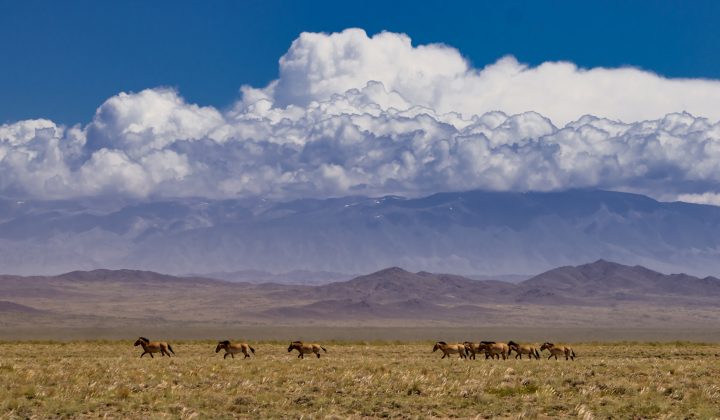
Leitung

Research interests
From basic everyday foraging behaviors to extraordinary long-distance migrations: animal movements are important for species survival, ecosystem functioning, and biodiversity. My research bridges across theoretical and applied aspects of movement ecology, from the behavioral underpinnings and social interactions to ecosystem functions and macro-ecological patterns. I am particular interested in studying the exceptional challenges that an increasing human footprint poses for movements of wildlife, which ultimately leads to the question of human wildlife coexistence. To that end, I pursue an integrated social-ecological research program to better understand human wildlife interactions and develop sustainable conservation recommendations.
External links
List of publications on Google Scholar
Selected publications
Tucker, M. , … , and T.Mueller. 2018. Moving in the Anthropocene: Global reductions in terrestrial mammalian movements. Science, 359, 466-469.
Bracis C. and T. Mueller. 2017. Memory, not just perception, plays an important role in terrestrial mammalian migration. Proceedings B, 284, 20170449.
Teitelbaum C.S., S. Converse, W. Fagan, K. Böhning-Gaese, R. B. O’Hara, A. Lacy, and T. Mueller. 2016. Experience drives innovation of new migration patterns of whooping cranes in response to global change. Nature Communications, 7,12793.
Teitelbaum C.S., W.F. Fagan, C.H. Fleming, G. Dressler, J.M. Calabrese, P. Leimgruber, and T. Mueller. 2015. How far to go? Determinants of migration distance in land mammals. Ecology Letters, 18, 545–552.
Mueller T., R. B. O’Hara, S. J. Converse, R.P. Urbanek, W. F. Fagan. 2013. Social Learning of Migratory Performance. Science, 341, 999-1002.
featured among others in:
BBC
NPR
National Geographic
Deutschlandfunk


Team
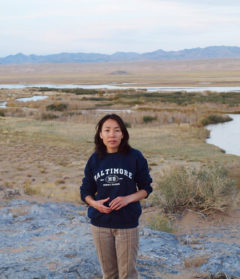
Research interests
My research interests focus on habitat selection and movement ecology of large mammalian herbivores. I am studying their long-distance movement behaviour and the effect of infrastructure-driven development on these movements in desert, semi-desert and steppe ecosystems in Mongolia. Mongolia has some of the largest remaining grassland and desert ecosystems that are critical habitat for khulan (Equus hemionus), goitered gazelles (Gazella subgutturosa) and Mongolian gazelles (Procapra gutturosa). In the past decade, however, large-scale mining projects for coal, copper and gold as well as infrastructure-based economic development projects have emerged in Mongolia’s drylands. These developments often pose barriers to animal movements and threaten their survival. I aim to better understand how mammalian herbivores react to barriers and how the detrimental effects of anthropgenic develoments in one of the last big migration systems can be mitigated.
Nandintsetseg, D., Bracis, C., Leimgruber, P., Kaczensky, P., Buuveibaatar, B., Lkhagvasurn, B., Chimeddorj, B., Enkhtuvshin, Sh., Horning, N., Ito, T. Y., Olson, K., Payne, J., Walzer, C., Shinoda, M., Stabach, J., Songer, M., Mueller, T (2019). Variability in nomadism: Environmental gradients modulate movement behaviors of dryland ungulates. Ecosphere. https://doi.org/10.1002/ecs2.2924
Nandintsetseg, D., Bracis, C., Olson, K. A., Böhning-Gaese, K., Calabrese, J. M., Chimeddorj, B., Fagan, W. F., Fleming, C. H., Heiner, M., Kaczensky, P., Leimgruber, P., Munkhnast, D., Stratmann, T., Mueller, T (2019). Challenges in the conservation of wide-ranging nomadic species. Journal of Applied Ecology. https://doi.org/10.1111/1365-2664.13380
Joly, K., Gurarie, E., Sorum, M. S., Kaczensky, P., Cameron, M.D., Jakes, A. F., Borg, B. L., Nandintsetseg, D., Hopcraft, J. G., Buuveibaatar, B., Jones, P. F., Mueller, T., Walzer, C., Olson, K. A., Payne, J., Yadamsuren, A., Hebblewhite, M (2019). Scientific Reports. https://doi.org/10.1038/s41598-019-51884-5
Tucker, M.A.,…, Nandintsetseg, D.,…, & Mueller, T. (115 authors) (2018). Moving in the Anthropocene: Global reductions in terrestrial mammalian movements. Science. https://doi.org/10.1126/science.aam9712
Fleming, C. H., Sheldon, D., Fagan, W. F., Leimgruber, P., Mueller, T., Nandintsetseg, D., Noonan, M. J., Olson, K. A., Setyawan, E., Sianipar, A., Calabrese, J. M (2018). Correcting for missing and irregular data in home ‐ range estimation. Ecological Applications. https://doi.org/10.1002/eap.1704
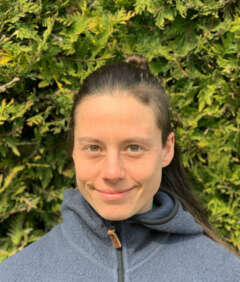
My main research interests are human relationships with, and the conservation of nature in general and wildlife in particular. For my PhD at Greifswald University, I investigated genetic aspects of lesser horseshoe bat recolonization in Central Germany. During the associated fieldwork and interaction with roost managers and other stakeholders, I discovered my interest for the human dimensions of wildlife conservation. As a postdoc at the Senckenberg Biodiversity and Climate Research Centre, I am currently implementing two projects addressing socio-psychological aspects of wolf conservation, with a strong focus on the role of factual knowledge. (You are invited to test your own knowledge about wolves in my Leibniz quiz.) Inspired by this work and my integrative nature education training (Wildnispädagogik), I have also developed a keen interest in human-nature relationships in general and their ramifications for nature conservation and people’s quality of life.
Peer-reviewed publications
Lehnen, L., Arbieu, U., Böhning-Gaese, K., Díaz, S., Glikman, J.A., Mueller, T. (2022). Rethinking individual relationships with entities of nature. People and Nature, 3(7). https://doi.org/10.1002/pan3.10296
Lehnen, L., Mueller, T., Reinhardt, I., Kaczensky, P., & Arbieu, U. (2021). Gesellschaftliche Einstellungen zur Rückkehr des Wolfs nach Deutschland. Natur und Landschaft, Schwerpunktausgabe: Luchs und Wolf zurück in Deutschland, 27–33. https://www.natur-und-landschaft.de/de/news/gesellschaftliche-einstellungen-zur-ruckkehr-des-wolfs-nach-deutschland-1617
de Boon, A., Sandström, C., Arbieu, U., Hansen, I., Lehnen, L., Marino, A., Pohja-Mykrä, M., Risvoll, C., Strand, G.-H., & Rønningen, K. (2021). Governing dual objectives within single policy mixes: An empirical analysis of large carnivore policies in six European countries. Journal of Environmental Policy & Planning, 23(4), 399–413. https://doi.org/10.1080/1523908X.2020.1841614
Lehnen, L.*, Jan, P.-L., Besnard, A.-L., Fourcy, D., Kerth, G., Biedermann, M., Nyssen, P., Schorcht, W., Petit, E. J., & Puechmaille, S. J. (2021). Genetic diversity in a long-lived mammal is explained by the past’s demographic shadow and current connectivity. Molecular Ecology, 30(20), 5048–5063. https://doi.org/10.1111/mec.16123 (*Lehnen & Jan equally contributed to this work as first authors. Petit & Puechmaille equally contributed as senior authors.)
Jan, P.-L., Lehnen, L.*, Besnard, A.-L., Kerth, G., Biedermann, M., Schorcht, W., Petit, E. J., Le Gouar, P., Puechmaille, S. J. (2019). Range expansion is associated with increased survival and fecundity in a long-lived bat species. Proceedings of the Royal Society B: Biological Sciences, 286(1906), 20190384. https://doi.org/10.1098/rspb.2019.0384 (Lehnen & Jan equally contributed to this work as first authors. Petit, Le Gouar, and Puechmaille equally contributed as senior authors.)
Lehnen, L., Schorcht, W., Karst, I., Biedermann, M., Kerth, G., & Puechmaille, S. J. (2018). Using Approximate Bayesian Computation to infer sex ratios from acoustic data. PLOS ONE, 13(6), e0199428. https://doi.org/10.1371/journal.pone.0199428
Zarzoso‐Lacoste, D.*, Jan, P., Lehnen, L., Girard, T., Besnard, A., Puechmaille, S. J., & Petit, E. J. (2018). Combining noninvasive genetics and a new mammalian sex‐linked marker provides new tools to investigate population size, structure and individual behaviour: An application to bats. Molecular Ecology Resources, 18(2), 217–228. https://doi.org/10.1111/1755-0998.12727 (*Zarzoso-Lacoste & Jan equally contributed to this work as first authors.)
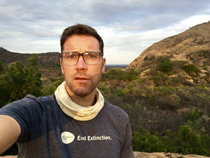
Research interests
My PhD research on the spatial and movement ecology of giraffe, with a special focus on the reticulated giraffe (Giraffa reticulata). Using aerial and tracking data to understand the factors driving giraffe habitat occupancy, preferences, seasonal movements, and co-existence dynamics with humans and livestock. In addition to forwarding giraffe science, we hope this research will inform giraffe conservation and land protection decisions and community-led conservation efforts.
I am based in San Diego, California, USA where I am employed as a researcher with the San Diego Zoo Institute for Conservation Research, where in addition to co-leading the collaborative community based Twiga Walinzi reticulated giraffe conservation and multi-disciplinary socio-ecological research program in northern Kenya, I am also involved in leopard (Panthera pardus) and savannah elephant (Loxodonta africana) conservation and research. I work in SE Asia as part of a team with local partners on research to address the illegal wildlife trade in bears and bear parts, saiga horn and tiger parts, as well beginning to developing research to inform a potential Asiatic black bear (Ursus thibetanus) rewilding effort in northern Laos. More recently, we have been supporting new research on former working elephants in Myanmar for possible re-introduction. Lastly I support saiga (Saiga tatarica) conservation and education efforts in Uzbekistan and southern Russia. I am a member of the IUCN Giraffe and Okapi Specialist Group, and the IUCN Bear Specialist Group.
External links
David O’Connor at ResearchGate (incl. full list of publications)
Recent publications
Muneza, A., Doherty, J.B., Hussein Ali, A., Fennessy, J., Marais, A., O’Connor, D. & Wube, T. (2018): Giraffa camelopardalis ssp. reticulata. The IUCN Red List of Threatened Species 2018 e.T88420717A88420720.
Davis, E., D. O’Connor, B. Crudge, A. Carignan, J. Glickman, C. Browne-Nunez, M. Hunt (2016): Understanding public perceptions and motivations around bear part use: A study in northern Laos of attitudes of Chinese tourists and Lao PDR nationals. Biological Conservation 203: 282-289.
Crudge, B., D. O’Connor, M. Hunt, E. Davis, and C. Browne-Nuñez (2016): Groundwork for effective conservation education: an example of in situ and ex situ collaboration in South East Asia. International Zoo Yearbook, 50: 1748-1090.
O’Connor, D.A., B. Butt, and J.B. Foufopoulos (2016): Mapping the ecological footprint of large livestock overlapping with wildlife in Kenyan pastoralist landscapes. African Journal of Ecology, 54(1):114-117. [Published online October 2015]
O’Connor, D., B. Crudge, E. Davis, M. Hunt, J. Harris, C. Browne-Nuñez, K Pesei, and E. Blint (2015): Understanding attitudes and usage of wild bear parts in Laos and Cambodia: A preliminary study using citizen scientists. Cambodian Journal of Natural History, 1: 67-68.
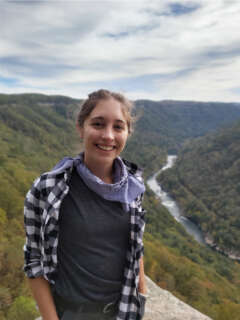
RESEARCH INTERESTS
Throughout my career path as a conservation ecologist, I have grown a strong interest in social-ecological research as today’s humanity challenges require interdisciplinary approaches. My work has metamorphosed from studying “the dilemma of plants” in Argentina, landscape genetics in Midwestern United States to forest connectivity conservation in Virginia’s coupled human-natural system. These experiences have shaped the way I view conservation issues, and how relevant people’s values are in order to facilitate sustainable relationships with nature.
For my Ph.D. project within the Movement Ecology Lab and part of the DFG-funded KiLi-SES Research Unit, I will identify and quantify which biodiversity components underpin the supply of non-material nature’s contributions to people (NCP), associated with physical and psychological experiences. In addition, I will evaluate how the relation between non-material NCP and biodiversity components vary along climatic and land use gradients. To do this, I will use different approaches to link demands for and values of NCP from multiple stakeholders with biodiversity data collected on Kilimanjaro’s southern slopes. We hope that the KiLi project will provide an integrated approach to help promote long-term strategic solutions in the face of a changing world.
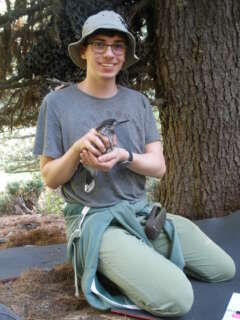
Research interests
My research interests focus on understanding how changes in human land use drive changes in animal movement behaviour, and how we may use those insights to make decisions in biodiversity conservation.
As part of the BMBF-funded MORE STEP project, my current research focuses on the movement of Mongolian Gazelles in the Mongolian Eastern Steppe Ecosystem. I want to understand how the ongoing industrial development in the steppe has impacted gazelle movement behaviour during the last decade, and how gazelles use or react to anthropogenic features like streets or resource extraction sites, as well as how they interact with the increasing number of livestock.
I am also interested in the social transmission of movement behaviour. Since my time as a master student, I study the migratory behaviour of Whooping Cranes in the eastern and mid-western USA. Here I want to understand how differences in social learning of migration can inform differences in migratory behaviour. In particular, I want to discern whether differences in the migration and wintering behaviour of those long-lived, social, migratory birds could potentially be attributed to different strategies of knowledge transmission in different populations, including human interference via hand-rearing and guided migration training.
Previously, I studied the occurrence of ticks (Ixodida) in recreational areas around the city of Karlsruhe (Germany) and how their presence could be linked to environmental factors like temperature, humidity and vegetation density.

Research interests
I have a strong interest in wildlife biology, behavioral ecology and conservation of large mammals and especially of large carnivores. I am based at the LUPUS Institute – the German Institute for Wolf monitoring and research which I co-founded together with my colleague Gesa Kluth. Since 2002 I am scientifically following and documenting the recovery of wolves in Germany. With this PhD study at the movement ecology group in Frankfurt I aim to give a profound scientific description of the population recovery, especially on the re-colonization process of wolves in Germany, the dispersal and pack formation of this new population, and on the territory size, movement and activity of wolves in the highly human dominated landscape of Germany. The study will hopefully contribute to a better understanding of this controversial carnivore. I am a member of the Large Carnivore Initiative for Europe (www.lcie.org), a species specialist group of the IUCN.
External Links
Ilka Reinhardt at ResearchGate (incl. full list of publications)
Selected publications
Lesnjak, I., Heckmann, I., Heitlinger, E., Szentiks, C. A., Jarausch, A., Reinhardt, I., Kluth, G., Hofer, H. and O. Krone (2017): Population expansion and individual age effect endoparasite richness and diversity in a recolonizing large carnivore population. Scientific reports 7:41730. doi: 10.1038/srep41730
Reinhardt, I., Kluth, G., Nowak, S. & R. Myslajek (2015): Standards for the monitoring of the Central European wolf population in Germany and Poland. BfN-Skripten 398.
Boitani, L., F. Alvarez, O. Anders, H. Andren, E. Avanzinelli, V. Balys, J. C. Blanco, U. Breitenmoser, G. Chapron, P. Ciucci, A. Dutsov, C. Groff, D. Huber, O. Ionescu, F. Knauer, I. Kojola, J. Kubala, M. Kutal, J. Linnell, A. Majic, P. Mannil, R. Manz, F. Marucco, D. Melovski, A. Molinari, H. Norberg, S. Nowak, J. Ozolins, S. Palazon, H. Potocnik, P.-Y. Quenette, I. Reinhardt, R. Rigg, N. Selva, A. Sergiel, M. Shkvyria, J. Swenson, A. Trajce, M. Von Arx, M. Wolfl, U. Wotschikowsky, D. Zlatanova (2014): Key actions for Large Carnivore populations in Europe. Institute of Applied Ecology (Rome, Italy). Report to DG Environment, European Commission, Bruxelles. Contract no. 07.0307/2013/654446/SER/B3.
Chapron, G., Kaczensky, P., Linnell, J.D.C., von Arx, M., Huber, D., Andrén, H., López-Bao, J.V., Adamec, M., Álvares, F., Anders, O. Balciauskas, L., Balys, V., Bedo, P., Bego, F., Blanco, J.C., Breitenmoser, U., Brøseth, H., Bufka, L., Bunikyte, R., Ciucci, P., Dutsov, A., Engleder, T., Fuxjäger, C., Groff, C., Heltai, M., Holmala, K., Hoxha, B., Yorgos, I., Ionescu, O., Ivanov, G., Jeremić, J., Jerina, K., Kluth, G. Knauer, F., Kojola, I., Kos, I., Krofel, M., Kubala, J., Kunovac, S., Kusak, J., Kutal, M., Mannil, P., Manz, R., Marboutin, E., Marucco, F., Melovski, D., Mersini, K. Mertzanis, Y., Mysłajek, R.W., Nowak, S., Odden, j., Ozolins, J., Palomero, G., Paunovic, M., Persson, J., Potočnik, H., Quenette, P-Y., Rauer, G., Reinhardt, I., Rigg, R., Ryser, A., Salvatori, V., Skrbinšek, T., Skrbinšek-Majić, A., Stojanov, A., Swenson, J.E., Trajçe, A., Tzingarska-Sedefcheva, E., Váňa, M., Veeroja, R., Wölfl, M., Wölfl, S., Zimmermann, F., Zlatanova, D. & L. Boitani (2014): Recovery of large carnivores in Europe ’s modern human-dominated landscapes. Science. VOL 346 ISSUE 6216. S. 1517-1519. doi: 10.1126/science.1257553
Reinhardt, I., Rauer, J., Kluth, G., Kaczensky, P., Knauer, F. & U. Wotschikowsky (2012): Livestock protection methods applicable for Germany – a Country newly recolonized by wolves. Hystrix, It. J. Mamm. doi: 10.4404/hystrix-23.1-4555

Research interests
My research aims to understand how individual phenotypic differences and ecology shape animal social structure and the consequences of this for various processes such as reproduction and information transmission. Currently, I am interested in exploring how diverse human activities impact animal movement and intraspecific interactions. More specifically, my research project examines how recreation activities and anthropogenic food sources in the German/Austrian Alps impact the behaviour of alpine choughs (Pyrrhocorax graculus). I investigate individual differences in the birds’ utilization of anthropogenic food sources and their impact on dyadic social associations, how spatiotemporal variation in anthropogenic resource availability shapes animal social network structure, and whether and how anthropogenic resources influence population processes. I study these questions using GPS-tracking, behavioural observations, field experiments and a range of analytical approaches such as social network analysis and network-based diffusion models.

Research interests
Animal movement is an integral part of the fabric of life on Earth. My research focuses on the patterns, drivers, consequences, and challenges of terrestrial animal movement from local to global scales in today’s changing world. Spanning the Asian highlands and the American West, I am particularly interested in the complex social-ecological landscapes mobile wildlife share with diverse human communities. Using interdisciplinary perspectives and methodologies integrating movement ecology, community ecology, land use science, and social science, I hope to contribute to a more connected world for both humans and nature.
External Links
Personal Website
Google Scholar
ResearchGate
Selected publications
Xu, W., Gigliotti, L., Royauté, R., Sawyer, H., Middleton, A. (2023). High fence density amplifies individual differences in movement with implications on survival in two migratory herbivores. Journal of Animal Ecology. 92(3): 677-689.
Xu, W., Huntsinger, L. (2022). Minding the boundary: social-ecological contexts for fence ecology and management. Frontiers in Ecology and the Environment. 20(7):405-412.
Giglioti, L., Xu, W , Zuckerman, G. R., Atwood, M. P., Cole, E. K., Courtemanch, A., … & Middleton, A. D. (2022). Wildlife migrations highlight importance of both private lands and protected areas in the Greater Yellowstone Ecosystem. Biological Conservation. 275: 109752.
Xu, W., Barker, K.†, Shawler, A.†, Van Scoyoc, A.†, …, Middleton, A. (2021). The plasticity of ungulate migration in a changing world. Ecology. 102.4: e03293.
Xu, W., Nandintsetseg, D., Sawyer, H., Middleton, A. (2021). Barrier Behavior Analysis (BaBA) reveals extensive effects of fencing on wide-ranging animals. Journal of Applied Ecology. 58.4 (2021): 690-698.
Alumni
Research interests
How can we find a way to have people and wildlife coexisting in a peaceful and structured way? Many of today´s challenges we experience are complex and multicausal. This is why I am very interested in combining different fields of research to find solutions with an interdisciplinary approach.
I am currently completing my Bachelor in Biological Sciences by doing my Bachelor Thesis at SBiK-F. The topic I am working on is the return of the wolves in Germany and public perceptions. This includes the evaluation of human emotional responses to wolves in different situations, using a social survey. The long term aim is to obtain a better understanding of the role emotions in conflicts involving human-wolf interactions. In my further studies I want to learn more about the different approaches to sustainability.
Research interests
Having a broad interest in the behaviour and conservation of large mammals, I am especially interested in the related human-wildlife conflicts being current topics not only in science but in politics and society as well. One of the most recent issues in Germany is the return of wolves. For my Master Thesis, I am working at SBiK-F and conduct a media analysis concerning wolves in Germany to better understand how the shaping of information influences public perception on this topic. In this the focus is set on the relationships between emotions and stakeholders as depicted in online and printed newspaper articles which have been published since wolves‘ return in 2000 until 2018.
I did my Bachelor at the Goethe Universität in Frankfurt working with the movement and behaviour of giraffe, zebra, impala and wildebeest in a shared enclosure in the Opel Zoo and moved to the Christian Albrechts Universität zu Kiel to pursue my Master studies.
B.S. Biowissenschaften (specialised on ecology)
at Goethe Universität, Frankfurt am Main, Germany
Currently M.S. Biologie (specialising on ecology)
at Christian Albrechts Universität, Kiel, Germany

Research interests
My research is at the interface between behavioral ecology, spatial ecology, and wildlife biology. I have previously worked on the effects of spatial and temporal variation in food abundance and hunting disturbance on behavior and life histories of Scandinavian brown bears. My current project is funded by the EU Marie Skłodowska-Curie actions under the grant agreement No 793077 . I am jointly working with the movement ecology group here in Frankfurt and the Scandinavian Brown Bear Research Project on consistent individual variation in the behavior of brown bears. It particularly interests me, to which degree such “bear personalities” are formed by maternal learning, individual learning, genetic relatedness, and variation in the environment.
Since May 2020 I am working together with researchers from the Ben-Gurion University in Israel on a project evaluating survival and performance of Egyptian vultures raised in captivity and release into the wild (German- Israeli Foundation for Scientific Research and Development: I-1465-413.13/2018 ). This project is of high conservation priority.
External links
www.bearproject.info
Full list of publications on Google Scholar
Recent publications
Hertel AG, Niemelä P.T., Dingemanse N.J., Mueller, T. (2020): A guide for studying among-individual behavioral variation from movement data in the wild. Movement Ecology. doi: 10.1186/s40462-020-00216-8
Lodberg-Holm HK, Gelink HW, Hertel AG, Swenson JE, Steyaert SMJG (2019): A human-induced landscape of fear influences foraging behavior of brown bears. Basic and Applied Ecology. doi: 10.1016/j.baae.2018.12.001
Hertel AG, Zedrosser A, Kindberg J, Langvall O, Swenson JE (2019): Fluctuating Mast Production Does not Drive Scandinavian Brown Bear Behavior. Journal of Wildlife Management. doi: 10.1002/jwmg.21619
Hertel AG, Leclerc M, Warren D, Pelletier F, Zedrosser A, Mueller T (2019): Don’t poke the bear: Using tracking data to quantify behavioural syndromes in elusive wildlife. Animal Behaviour. doi: 10.1016/j.anbehav.2018.11.008
Hertel AG, Bischof R, Langval O, Mysterud A, Kindberg J, Swenson JE, Zedrosser A (2018): Berry production drives bottom-up effects on body mass and reproductive success in an omnivore. Oikos 127:197-207, doi: 10.1007/s00265-016-2106-2
Frank SC, Ordiz A, Gosselin J, Hertel AG et al. (2017): Indirect effect of bear hunting: A review from Scandinavia. Ursus 29:150-165, doi: 10.2192/URSU-D-16-00028.1
RESEARCH INTERESTS
I am a behavioral ecologist who studies how animals to cope with environmental changes resulting from human activities. My research has primarily focused on phenotypic integration between behavior and other components of the phenotype (morphology, physiology, life-history) to understand the ecology and evolution of populations. I have investigated these topics by focusing on how environmental stressors (contaminant, diet quality and availability) affect the magnitude of phenotypic integration and used quantitative genetic approaches to compare patterns of integration among populations and sexes. Within the Movement Ecology group and the Nature 4.0 project, I will use automated tracking technologies to characterize variation in movement patterns of forest birds and will link this variation to broader ecosystem functions (predation and herbivory regulation).
EXTERNAL LINKS
SELECTED PUBLICATIONS
Hertel, A. G., R. Royauté, A. Zedrosser, and T. Mueller. 2020. Biologging reveals individual variation in behavioural predictability in the wild. Journal of Animal Ecology (Early View). doi: 10.1111/1365-2656.13406
Royauté, R., A. Hedrick, and N. A. Dochtermann. 2020. Behavioural syndromes shape evolutionary trajectories via conserved genetic architecture. Proceedings of the Royal Society B: Biological Sciences 287:20200183. doi: 10.1098/rspb.2020.0183
Royauté, R., M. A. Berdal, C. R. Garrison, and N. A. Dochtermann. 2018. Paceless life? A meta-analysis of the pace-of-life syndrome hypothesis. Behavioral Ecology and Sociobiology 72:64. doi: 10.1111/1365-2656.13406
Royauté, R., Buddle, C. M. and C. Vincent. 2015. Under the influence: Sublethal exposure to an insecticide affects personality expression in a jumping spider. Functional Ecology 29: 962-970. doi: 10.1111/1365-2435.12413
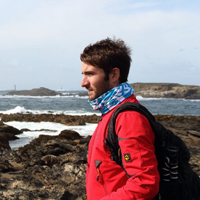
Research interests
The conservation of large mammals, and large carnivores in particular, requires integrative perspectives ranging from genetics, population and movement ecology to understand their ecology, as well as psychology, social and political sciences to address potential conflicts with human societies. Research on social-ecological systems provides frameworks to bring these formerly separate scientific domains together and find solutions for human-wildlife coexistence.
My DFG-funded PhD project with Prof. K. Böhning-Gaese focused on wildlife tourism as a cultural ecosystem service, with a specific emphasis on large mammal diversity in four protected areas of Southern Africa (Etosha National Park, Chobe National Park, Kruger National Park and Hluhluwe-Imfolozi Park).
My current Senckenberg Postdoc project focusses on the social-ecological implications of the wolf (Canis lupus) returning to Germany. I use methods from ecological and social sciences to understand how wolves and people can coexist in human-dominated landscapes, and hopefully provide solutions for long-term and sustainable coexistence. The Leibniz-funded Transfer Project KnowWolf “Transfer of evidence-based and co-produced Knowledge for Human-Wolf Coexistence” (3 years), aims at reducing the gap between Science and Society on the topic of human-wolf coexistence, across borders.
Within the DFG-funded Kili-SES Research Unit, I investigate which biodiversity components underpin non-material nature’s contributions to people, by linking biodiversity data collected on Kilimanjaro’s southern slopes, and societal demands from multiple stakeholders groups.
Selected publications
Lehnen, L., Mueller, T., Reinhardt, I., Kaczensky, P. & Arbieu, U. (2021) Gesellschaftliche Einstellungen zur Rückkehr des Wolfs nach Deutschland. Natur und Landschaft, 1, 27-33.
de Boon, A., Sandström, C., Arbieu, U., Hansen, I., Lehnen, L., Marino, A., Pohja-Mykrä, M., Risvoll, C., Strand, G-H. & Rønningen, K. (2020) Governing dual objectives within single policy mixes: An empirical analysis of large carnivore policies in six European countries. Journal of Environmental Policy and Planning.
Methorst, J., Arbieu, U., Bonn, A., Böhning-Gaese, K. & Mueller, T. (2020) Non-material contributions of wildlife to human well-being: a systematic review. Environmental Research Letters, 15, 093005.
Arbieu, U., Albrecht, J., Mehring, M., Bunnefeld, N., Reinhardt, I. & Mueller, T. (2020) The positive experience of encountering wolves in the wild. Conservation Science and Practice, 2, e184.
Arbieu, U., Mehring, M., Bunnefeld, N., Reinhardt, I., Kaczensky, P., Nowak, C., Ansorge, H., Glikman, J., Böhning-Gaese, K. & Mueller, T. (2019) Attitudes towards returning wolves (Canis lupus) in Germany: Exposure, Information sources and Trust matter. Biological Conservation, 234, 202-210.
Arbieu, U., Grünewald, C., Martín-López, B., Schleuning, M. & Böhning-Gaese, K. (2018) Large mammal diversity matters for wildlife tourism in Southern African protected areas: insights for management. Ecosystem Services, 31, 481-490.
Balvanera, P., Calderón-Contreras, R., Castro, A.J., Felipe-Lucia, M.R., Geijzendorffer, I.R., Jacobs, S., Martín-López, B., Arbieu, U., Ifejika Speranza, C., Locatelli, B., Pérez Harguindeguy, N., Ruiz Mercado, I., Spierenburg, M.J., Vallet, A., Lynes, L. & Gillson, L. (2017) Interconnected place-based social–ecological research can inform global sustainability. Current Opinion in Environmental Sustainability, 29, 1-7.
Arbieu, U., Grünewald, C., Schleuning, M. & Böhning-Gaese, K. (2017) The importance of vegetation density for tourists’ wildlife viewing experience and satisfaction in African savannah ecosystems. PLoS ONE, e0185793.
Arbieu, U., Grünewald, C., Martín-López, B., Schleuning, M. & Böhning-Gaese, K. (2017) Mismatches between supply and demand in wildlife tourism: insights for assessing cultural ecosystem services. Ecological Indicators, 78, 282-291.

With my research, I aim to advance our knowledge on how (changing) environmental conditions and human activities impact animal behaviour, movement, and space use, and thus, ultimately, populations’ distribution and abundance. By exploring these issues both using field-based methods and ‘remotely’ by combining biologging data (e.g., GPS, accelerometer, body temperature, and heart rate data) with various modelling approaches, I strive to provide robust insights that contribute to a mechanistic understanding of species and ecosystem responses to global change, help mitigate human-wildlife conflicts, and provide a solid foundation for effective conservation. Thus far, my work was especially focussed on the foraging and movement ecology of large Arctic herbivores (reindeer and muskoxen) in Svalbard and Greenland. Within the “Nature 4.0 – Sensing Biodiversity”, I will use automated radio tracking data to investigate activity patterns of a forest bird community.
Pedersen, Å.Ø*., Beumer, L.T.*, Aanes, R. and Hansen, B.B. (2021) Sea or summit? Wild reindeer foraging responses to changing high-arctic winters. Ecosphere, 12, e03883. (*shared first author)
Street, G.M., Potts, J.R., Börger, L., Beasley, J.C., Demarais, S., Fryxell, J.M., McLoughlin, P.D., Merrill, E.H., Monteith, K.L., Prokopenko, C.M., Ribeiro, M.C., Rodgers, A.R., Strickland, B.K., van Beest, F.M., Bernasconi, D.A., Beumer, L.T., Dharmarajan, G., et al. (2021) Solving the Sample Size Problem for Species Distribution Models. Methods in Ecology and Evolution. 12, 2421-2431.
van Beest, FM, Beumer, L.T., Schmidt Andersen, A., Hansson, S.V. and Schmidt, N.M. (2021) Rapid shifts in Arctic tundra species’ distributions and inter-specific range overlap under future climate change. Diversity and Distributions. DOI: 10.1111/ddi.13362.
Chimienti, M., van Beest, F.M., Beumer, L.T., Desforges, J.-P., Hansen, L.H., Stelvig, M. and Schmidt, N.M. (2021) Quantifying ungulates’ behavior and life history events from year-long continuous accelerometer data. Ecosphere, 12, e03565.
Desforges, J.-P., Marques, G.M., Beumer, L.T., Chimienti, M., Hansen, L.H., Pedersen, S.H., Schmidt, N.M. and van Beest, F.M. (2021) Environment and physiology shape Arctic ungulate population dynamics. Global Change Biology, 27, 1-17.
Beumer, L.T., Pohle, J., Schmidt, N.M., Chimienti, M., Desforges, J.-P., Hansen, L.H., Langrock, R., Pedersen, S.H., Stelvig, M. and van Beest, F.M. (2020) An application of upscaled optimal foraging theory using hidden Markov modelling: year-round behavioural variation in a large arctic herbivore. Movement Ecology, 8, 25.
van Beest, F.M., Beumer, L.T., Chimienti, M., Desforges J.-P., Huffeldt, N.P., Pedersen, S.H. and Schmidt, N.M. (2020). Environmental conditions alter behavioural organization and rhythmicity of a large Arctic ruminant across the annual cycle. Royal Society Open Science, 7, 201614.
Desforges, J.P., van Beest, F.M., Marques, G.M., Pedersen, S.H., Beumer, L.T., Chimienti, M. and Schmidt, N.M. (2020) Quantifying energetic and fitness consequences of heterothermy. Ecology and Evolution, 11, 338-351.
Chimienti, M., Desforges, J.-P., Beumer, L.T., Nabe.Nielsen, J., van Beest, F.M. and Schmidt, N.M. (2020) Energetics as common currency for integrating high resolution activity patterns into dynamic energy budget-individual based models. Ecological Modelling, 434, 109250.
Schmidt, N.M., Grøndahl, C., Evans, A.L., Desforges, J.-P., Blake, J., Hansen, L.H., Beumer, L.T., Mosbacher, J.B., Stelvig, M., Greunz, E.M., Chimienti, M. and van Beest, F.M. (2020) On the interplay between hypothermia and reproduction in a high arctic ungulate. Scientific Reports, 10, 1-7.
Græsli, A.R., Le Grand, L., Thiel, A. Fuchs, B., Devineau, O., Stenbacka, F., Neumann, W., Ericsson, G., Singh, N., Laske, T., Beumer, L.T., Arnemo, J. and Evans, A. (2020) Physiological and behavioural responses of moose to hunting with dogs. Conservation Physiology, 8, coaa122.
Beumer, L.T., van Beest, F.M., Stelvig, M. and Schmidt, N.M. (2019) Spatiotemporal dynamics in habitat suitability of a large Arctic herbivore: Environmental heterogeneity is key to a sedentary lifestyle. Global Ecology and Conservation, 18, e00647.
Desforges, J.-P., Marques, G.M., Beumer, L.T., Chimienti, M., Blake, J., Rowell, J.E., Adamczewski, J., Schmidt, N.M. and van Beest, F.M. (2019) Quantification of the full lifecycle bioenergetics of a large mammal in the high Arctic. Ecological Modelling, 401, 27-39.
Hansen, B.B., Lorentzen, J.R., Welker, J.M., Varpe, Ø., Aanes, R., Beumer, L.T. and Pedersen, Å.Ø. (2019) Reindeer turning maritime: ice-locked tundra triggers herbivore foraging niche expansion in the high Arctic. Ecosphere, 10, e02672.
Beumer, L.T., Varpe, Ø. and Hansen, B.B. (2017) Changes in cratering and faecal diet quality as response to snow-pack characteristics in a high-Arctic ungulate. Polar Research, 36, 1286121.
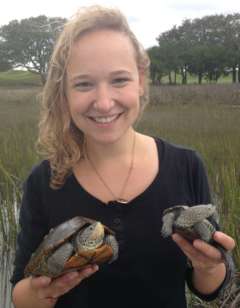
RESEARCH INTERESTS
My research interest is in conservation biology and how we can use math and modeling to make better decisions regarding conservation. While studying my master’s degree I used bog turtles (Glyptemys muhlenbergii) as a case study for how we can resource-efficiently locate and survey rare and elusive species. This work combined species distribution modeling and intensive field work in close collaboration with state wildlife agencies in the United States to give me first-hand experience into what it means to conserve species at ground-level. For my Ph. D. I am changing my focus to examine how movement affects population dynamics in highly mobile animals. My study system is the Eastern Steppe of Mongolia and the nomadic Mongolian Gazelles (Procapra gutturosa). I will simulate this system by programming an herbivore-vegetation model. To do this I am combining expertise from the two working groups I am involved in. I am a part of Thomas Müller’s group, whose focus is on movement ecology and conservation, and Thomas Hickler’s group, whose focus is on vegetation modeling and effects of climate change. We hope this modeling approach will help us better understand how important mobility is to long-term population persistence of animals living in unpredictable and dynamic landscapes.
Past Projects:
B.S. Ecology, Minor Mathematics, summa cum laude, The University of Georgia, Athens, GA, USA, (Lab of Dr. John Maerz: click here)
M.S. Wildlife and Fisheries Biology, Clemson University, Clemson, SC, USA, (Lab of Dr. Kyle Barrett: click here)
CURRENT PROJECTS
My work is part of the BMBF project MoreStep which brings together social and ecological sciences to identify societal drivers that can lead to an ecological tipping point of the Mongolian steppe ecosystem. Our role is to use the herbivore-vegetation model to examine the importance of movement in maintaining sustainable numbers of wild and domestic herbivores. The model will also be used to disentangle the effects of climate and grazing on vegetation.
Stratmann, T. S. M., T. Floyd, and K. Barrett (2020): Habitat and History Influence Abundance of Bog Turtles. The Journal of Wildlife Management 84(2):331–343. DOI: 10.1002/jwmg.21793
Nandintsetseg, D., C. Bracis, … , T. Stratmann, and T. Mueller. Challenges in the conservation of wide-ranging nomadic species. Journal of Applied Ecology. 56(8): 1916-1926.
Check out the animation I made for the paper here.
Stratmann, T. S. M., T. Floyd, and K. Barrett (2016): Locating suitable habitat for a rare species: evaluation of a species distribution model for Bog Turtles ( Glyptemys muhlenbergii) in the southeastern United States. Herpetological Conservation and Biology. 11(1): 199-213.
Munscher, E., A. Walde, T. S. M. Stratmann, and B. Butterfield (2015): Exceptional Growth Rates Observed in Immature Pseudemys from a Protected Spring System in Florida. Herpetology Notes. 8: 133-140.
Pierson, T., T. S. M. Stratmann, E. White, A. Clause, C. Carter, M. Herr, A. Jenkins, H. Vogel, M. Knoerr, and B. Folt (2014): New County Records of Amphibians and Reptiles Resulting from a Bioblitz Competition in North-Central Georgia, USA. Herpetological Review. 45(2): 296-297.
Floyd, T.M., T.S.M. Stratmann, G.J. Brown, III, and C.S. Pfaff (2013): Cryptobranchus alleganiensis alleganiensis. Terrestrial Movement. Herpetological Review. 44:651.
Stratmann, T. and S. Pfaff (2011): Geographic Distribution Note for Lampropeltis elapsoides. Herpetological Review. 42(4):572-573.

